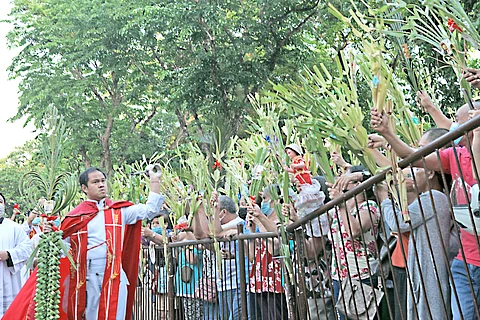
- NEWS
- the EDIT
- COMMENTARY
- BUSINESS
- LIFE
- SHOW
- ACTION
- GLOBAL GOALS
- SNAPS
- DYARYO TIRADA
- MORE

In the predominantly Catholic Philippines, Palm Sunday marks the beginning of Holy Week, an intense religious observance leading to Easter Sunday. This significant event is celebrated with great fervor and tradition, reflecting the deeply rooted faith of the Filipino people.
Palm Sunday commemorates Jesus Christ’s triumphant entry into Jerusalem, where crowds welcomed Him with shouts of “Hosanna” and waved palm branches, symbolizing victory and peace. In the Philippines, this day is marked by elaborate processions and rituals, with devotees waving palm fronds as they reenact the joyful scene of Jesus’ entry into the holy city.
Palm Sunday processions are a spectacle of faith and devotion in many towns and cities across the country. Dressed in their Sunday best, participants gather at churches to receive blessed palm leaves, often intricately woven into crosses or other designs. These palm fronds are then carried in procession, accompanied by hymns and prayers, as the faithful march through the streets, symbolically welcoming Jesus into their midst.
Throughout Holy Week, Filipinos engage in various religious practices and observances to commemorate the passion, death and resurrection of Jesus Christ. This period is marked by solemnity as believers reflect on Christ’s sacrifice and the significance of his resurrection.
On Holy Thursday, the Catholic Church commemorates the Last Supper, when Jesus instituted the sacrament of the Eucharist and washed his disciples’ feet. In the Philippines, this day is marked by the tradition of Visita Iglesia, where devotees visit seven different churches to pray and reflect on the Stations of the Cross. Many churches also hold Masses and reenactments of the Last Supper, emphasizing the importance of humility, service, and communion within the Christian community.
Good Friday is perhaps the most solemn day of Holy Week, commemorating the crucifixion and death of Jesus Christ. In the Philippines, this day is observed with solemn processions, penitential rites, and veneration of the Cross.
Devotees participate in the Stations of the Cross by physically walking the stations or attending solemn church services. Some communities even stage reenactments of the Passion of Christ, depicting his suffering and death in vivid detail.
Holy Saturday, or Black Saturday, is a day of quiet anticipation and reflection, as believers await the celebration of Christ’s resurrection. Many churches hold Easter Vigils, where the faithful gather for prayers, readings, and the blessing of the Easter fire and Paschal candle. This solemn vigil culminates in the joyful proclamation of Christ’s resurrection at midnight, marking the beginning of Easter Sunday.
Easter Sunday is the culmination of Holy Week, celebrating the resurrection of Jesus Christ and the victory of life over death. In the Philippines, this day is marked by festive Masses, processions, and gatherings with family and friends. Many communities hold Easter egg hunts and feasts, symbolizing the new life and hope brought by Christ’s resurrection.
Overall, the Holy Week commemoration in the Philippines is deeply ingrained in the country’s culture and tradition. It serves as a time of spiritual renewal, reflection, and celebration for millions of Filipino Catholics. Through rituals, processions, and prayers, believers reaffirm their faith and devotion to Christ, seeking to emulate his love, sacrifice, and resurrection in their own lives.
